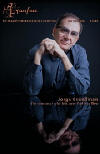Texte paru dans: / Appeared in:

Fanfare Magazine: 35:5 (05-06/2012)
Pour
s'abonner / Subscription information
Les abonnés à Fanfare Magazine ont accès aux archives du
magazine sur internet.
Subscribers to Fanfare Magazine have access to the archives of the magazine
on the net.
Zig-Zag Teritoires
ZZT 111001 (2CD)

3760009292529
Consultez toutes les évaluations recensées pour ce cd
~~~~ Reach all the evaluations located for this CD
Christopher Brodersen
The latest entry in the Goldberg Sweepstakes comes from French
harpsichordist Blandine Rannou, who began making recordings in the late ’90s
with Il Seminario Musicale and whose first solo CD on the Zig-Zag label was
released in 2001 (music of Rameau). Rannou has been mentioned four times in
past issues of Fanfare; her recording of the English Suites received a rave
review from Laura Rónai in 27:5. Let me be perfectly frank about this:
Rannou’s new recording of BWV 988 should not be the first, nor should it be
the only version in your library. But if you ascribe to the notion that
great works like the Goldbergs can tolerate—indeed, require—multiple,
contrasting interpretations in order to fully appreciate them, then you
should waste no time in ordering this set.
There are at least two features that distinguish Rannou’s playing of BWV 988 from all others: her highly unorthodox treatment of the opening Aria, and her extensive use of ornamentation. Rannou adopts a much slower tempo for the Aria than the norm; she drags it out to almost seven minutes, making it a kind of Main Event. I feel that this is somewhat anticlimactic since the piece no longer functions as a lead-in to the extraordinary series of variations that follows. Most harpsichordists evidently feel as I do; even with repeats, they seldom need more than about four minutes.
Even more controversial is Rannou’s approach to ornamentation. She plays all the repeats—nothing unusual about that—but every repeat is filled to the brim with added trills, mordents, runs, and arpeggios. For many listeners this amount of ornamentation might seem inappropriate in Bach. The jury is out on this issue, of course. Scholars are quick to say that performers in the Baroque era, save perhaps for the most unimaginative dullards, routinely placed their stamp on the music by ornamenting cadences and varying repeats. Perhaps Bach did this as well, even when he played his own, carefully notated music. My own view is that ornaments are, within reason, a welcome addition in the context of a live performance; on a recording, one tends to grow weary of them with repeated hearings.
Now that I’ve gotten the two potential negatives out of the way, let me say that this is some of the most exciting keyboard work I’ve heard in a long time. Rannou is a doggedly individualistic harpsichordist who injects every phrase, every measure with personality. Tempos are just about ideal; she dances in the gigue-like Variation 7, swaggers in the stately fughetta of Variation 10, negotiates the tricky crossed hands in Variation 11 with aplomb, and languishes convincingly in Variation 13. She plays Variation 14 at a faster tempo and with even more frisson than the jet-propelled Christophe Rousset, something that I would not have thought possible. Rannou employs the “buff” stop for the left hand of Variation 25, an impeccable registrational choice that heightens the melancholy of this movement. Variation 29 is the last, grand movement before the concluding da capo Aria; she plays it for maximum bravura effect. The Aria is heard without repeats and with minimal ornamentation; here the slow tempo is appropriate and effective.
The harpsichord is an excellent-sounding Ruckers-Hemsch copy by Anthony Sidey. I have nothing but admiration for the natural, non-gimmicky recording. This set may not be everyone’s desert-island version, but if you’re looking for an interpretation of the Goldbergs that will challenge, entertain, captivate, and ultimately deepen your understanding of this extraordinary work, look no further.
Cliquez l'un ou l'autre
bouton pour découvrir bien d'autres critiques de CD
Click either button for many other reviews


